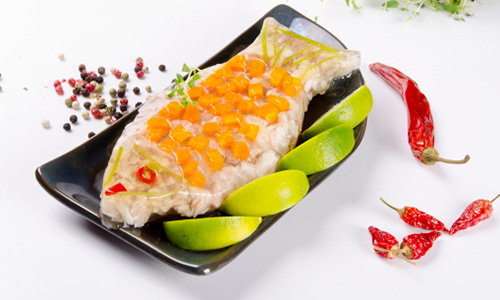
Ingredients for 4 servings:
- 2 onions
- 1 l vegetable broth (instant)
- 6 tbsp white wine vinegar
- 2-3 bay leaves
- 1 tsp allspice
- 1 tbsp peppercorns
- 1 chilli
- Salt
- 1 ready-to-cook carp (approx. 1 kg)
- 10 sheets of white gelatine or 15 g powdered gelatine (please follow manufacturer’s instructions or read tips for its use here)
- 2-3 carrots
- 1-2 tsp lime juice
- Pepper
- In addition:
- Chillies and lime as a garnish
Preparation:
- To make the stock, peel and dice onions. Simmer broth with vinegar, onions as well as bay leaves, allspice, peppercorns, chilli and 1 teaspoon of salt for approx. 5 minutes.
- In the meantime, wash and cut the carp in half, remove skin and cut the meat into small pieces. Add fish pieces to the stock and simmer for approx. 12 minutes on a low heat until tender.
- Meanwhile, soak gelatine in cold water. Peel carrots and slice into pieces – these will be used later to decorate the fish with scales. Cook for 5 - 8 minutes in salt water and then drain.
- Remove fish pieces from stock and let cool. Pour hot stock through a fine sieve that has been lined with a linen cloth. Squeeze out excess moisture from gelatine and dissolve in fish stock. Season with lime juice, salt and pepper.
- Place fish pieces into a fish or casserole dish. Decorate by arranging the carrot pieces on top as scales and then pour stock over everything – refrigerate for approx. 4 hours.
- To serve, garnish aspic fish with chilli rings and lime strips.
Click here for more information on cooking and baking with gelatine.
Nutritional values per person approx.:
- Calories: 695
- Joules: 2907
- Protein: 90.4 g
- Fat:22.4 g
- Carbohydrates: 30.8 g
The carp – a fish that keeps us healthy
As the carp has by now become a widely known species of fish, there are a wide range of options for its preparation. There is scarcely a region that has not created its own recipes.
With its lightly nutty flavour, carp meat is not only delicious, but also healthy and not as fat as most people think. Even though its meat is quite easy to remove from its bones, with only approx. 5 g of fat per 100 g of fish, the carp is considered a species of freshwater fish with a medium fat content. It is an important source of omega-3 and omega-6 fatty acids. Since the body cannot produce its own supply of these essential fatty acids, they need to be obtained from an outside source through the diet. The body uses them for many important metabolic processes. In addition to the production of hormones, which are important for the immune system, they are an essential building block for cell renewal. They thus prevent diseases and help speed up cell recovery.
By the way, to ensure that the tasty meat does not suffer in quality, carps are kept alive until shortly before they are prepared or sold. The fish are caught with nets and scoop nets and then transported in freshwater tanks. A positive side-effect: the carp meat loses the earthy flavour it develops because this species of fish primarily hunts its prey on the muddy bottom of its habitat.
Whether fried, braised, or cooked as a whole or enjoyed as a goulash or in aspic, the carp can be prepared in many different ways, developing its flavour in a wide range of styles.
Important: As any other fish, a carp has fish bones. Those on its back need to be removed; the meat of its stomach is boneless.
Bon Appétit!